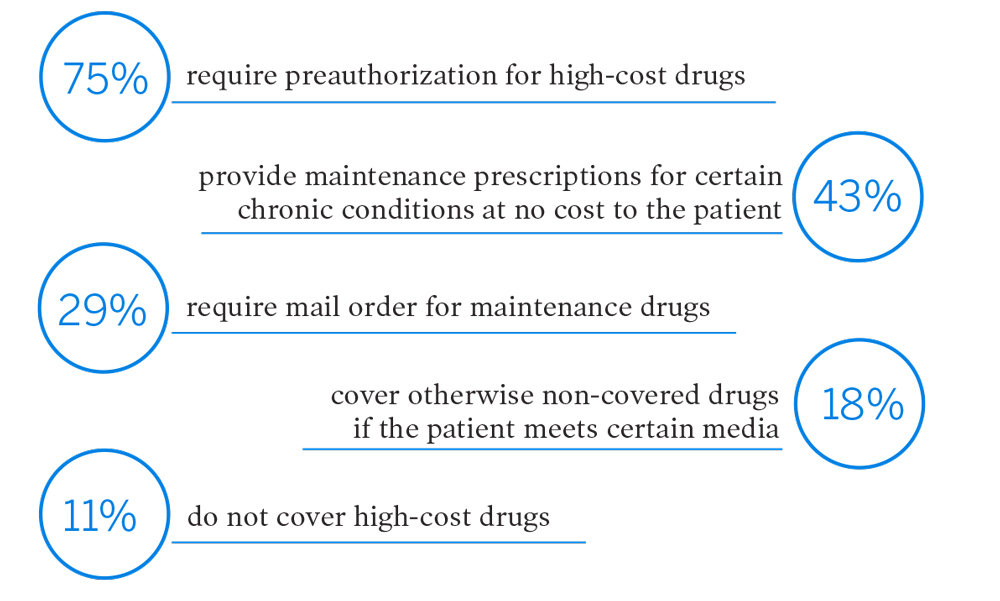Rising prescription drug costs is old news, and costs are only expected to climb higher, particularly due to the increased presence of specialty drugs. In fact, prescription drug costs will be the fastest growing health category and will consistently outpace other health spending.1 We asked you to tell us how you manage prescription drug costs. Clearly, strategies to rein in costs are giving you a headache, so take two aspirin and call your Milliman consultant.
Figure 1: Survey respondents by employee count
| 25,000+ employees | 7% |
| 10,001-25,000 employees | 7% |
| 5,001-10,000 employees | 14% |
| 2,001-5,000 employees | 25% |
| 501-2,000 employees | 29% |
| 101-500 employees | 11% |
| 100 or fewer employees | 7% |
Survey results indicated that respondents are currently using a number of methods to control pharmacy spend.
Figure 2: Most survey respondents have controls in place to manage prescription drug costs

With an overwhelming 75% of respondents indicating that they require prior authorization for high-cost drugs, clearly this is the most popular method currently in use. Other popular methods surround maintenance drugs, including offering them at no cost and requiring the use of mail-order.
The results seem to demonstrate a disconnect between the strategies that organizations currently employ vs. what they believe is the more effective solution. This could include reasons such as cost and lack of access to resources.
Figure 3: Many respondents believe working with a PBM is more effective to managing long-term drug costs, although most currently contract with a health carrier or third-party administrator
| How do you manage long-term drug costs? | Current Approach | Most Effective Approach |
|---|---|---|
| Contract directly with PBM (carve out) | 36% | 46% |
| Contact through a third party PBM Purchasing Coalition (carve out) | 24% | 42% |
| Contract through a Health Carrier to TPA | 56% | 27% |
| On-site Clinic | 16% | 11% |
| Direct Contract with a pharmacy chain | 4% | 15% |
Combined with the fact that 39% of respondents don’t know whether they are receiving the best deal from their pharmacy arrangement in regards to discounts and rebates, it’s clear that most are looking for a new strategy.
Beyond the majority of respondents not necessarily knowing they are getting the best deal with their pharmacy spend, there is a relatively even distribution between reliance on third-party expertise, be it consultant or PBM, and conducting regular maintenance with pharmacy benefits including audits, RFP, and examining contracts.
Figure 4: Almost 40% of respondents do not know if they are getting the best deal...
| Do you know if you’re getting the best deal on discounts or rebates? | Response |
|---|---|
| I don’t | 39% |
| I trust the Pharmacy Benefit Manager | 11% |
| I have periodic independent audits conducted | 18% |
| Use a consultant | 18% |
| I frequently review our contract | 7% |
| Other | 7% |
Finally, the perception of these resources seem to differ between who is most equipped vs. being most effective or responsible in managing cost. There doesn’t seem to be one clear choice as to who can be effective, responsible and objective when it comes to managing pharmacy cost.
It is evident from the results that the Pharmacy Benefit Manager is in the best position to be effective, there is a conflict with that resources ability to provide objective advice. On the other hand, the specialized consultant is objective, but perhaps the cost of such a resource offsets with reduced effectiveness.
Figure 5: ...And believe another vendor may do a better job managing drug costs than their current vendor
| Do you know if you’re getting the best deal on discounts or rebates? | Currently Responsible | Best Equipped to Provide Advice | Most Effective |
|---|---|---|---|
| Pharmacy Benefit Manager | 46% | 25% | 40% |
| Carrier / TPA | 29% | 7% | 12% |
| Benefit Broker / Consulting Firm | 18% | 18% | 8% |
| Specialized Consultant | 7% | 32% | 16% |
| Actuarial Consultant | 0% | 11% | 4% |
| Independent Medical Management Firm | 0% | 7% | 20% |